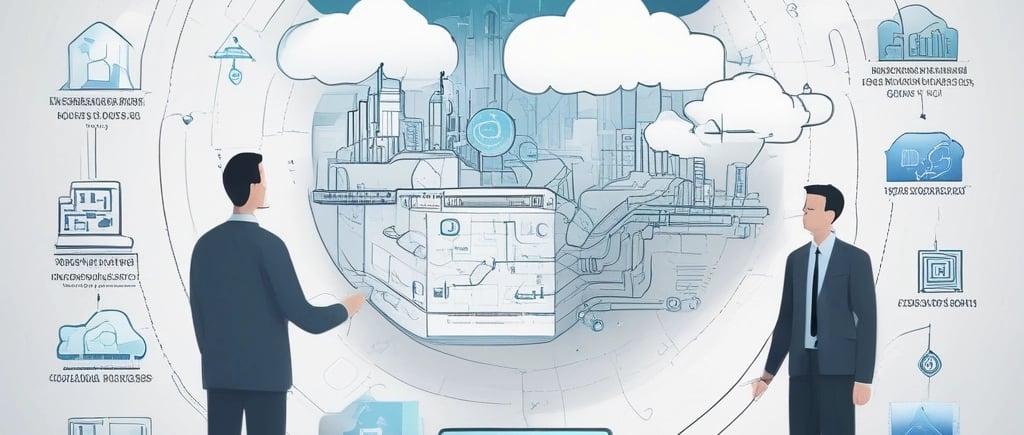Application modernization
Learn practical strategies to modernize legacy systems while maintaining business continuity. This guide explores step-by-step approaches to upgrading infrastructure, adopting cloud technologies, and improving performance—without disrupting day-to-day operations.
DIGITAL TRANSFORMATION
Roland RAKOTONDRABE
10/19/20254 min read


How to Modernize Legacy Systems Without Breaking Operations: A Comprehensive Guide
Legacy systems—the backbone of many organizations—often become barriers to innovation, efficiency, and growth. However, replacing them in one sweep carries huge risks. The good news? With strategic planning, modern frameworks, and evidence-backed best practices, you can modernize legacy systems without breaking your business operations. Here’s how successful companies do it, along with insights and key performance indicators to guide your journey.
1. What You Must Know Before Starting Modernization
Understand Your Legacy Landscape:
Begin with a thorough audit. Map all dependencies, integrations, business-critical tasks, and compliance factors. Recognize what can—and cannot—be disrupted.
Identify the Why:
Ask yourself: Why modernize? Is it to cut costs, scale up, move to the cloud, remain competitive, or secure regulatory compliance? Clear goals will steer your strategy and help you track success.
Risk Assessment:
Modernization, if poorly managed, risks outages, data loss, and unhappy users. Benchmark your uptime, error rates, transaction speeds, and support ticket volumes before any changes. This gives you a safety net: if anything goes wrong, you’ll know quickly and can course-correct.bayone+1
2. Types of Legacy System Modernization
Not all modernization efforts look the same. Below are proven approaches—with real-world illustrations—for transforming your systems:
A. Rehosting (Lift and Shift)
Example:
Several banks rehosted transaction platforms directly to cloud infrastructure. This approach allowed them to cut IT spending by up to 35% annually while protecting core operations.avato+1
Best for:
Fast migrations for systems requiring minimal change—infrastructure or platform-level upgrades.
KPI:
Migration rate, IT cost reduction, post-migration uptime.
B. Replatforming
Example:
Tech companies shifted from legacy databases to managed cloud databases. This unlocked new features while containing risk.
Best for:
Upgrading underlying technology without changing business logic, especially databases and OS.
KPI:
Platform adoption rate, performance upgrade (response times).
C. Refactoring / Re-architecting
Example:
A biopharma organization refactored operations for cloud-compliance and scalability, boosting regulatory response and accelerating innovation.hcltech
Best for:
Modernizing code, embracing microservices, moving beyond simple platform upgrades.
KPI:
Error-rate reduction, regulatory compliance, agility improvements.
D. Redevelopment (Complete Overhaul)
Example:
Manufacturing firms rewrote platforms with modern frameworks, slashing maintenance costs by 70% and speeding up product launches by 20x.coherentsolutions+2
Best for:
Systems where incremental upgrades aren’t feasible or cost-effective.
KPI:
Deployment cycle time, support ticket reduction, long-term ROI.
E. Integration
Example:
Banks layered new payment gateways via APIs onto old core banking solutions, incorporating new customer features without rewriting existing platforms.avato
Best for:
Extending features using APIs, connecting to modern ecosystems with minimal risk.
KPI:
Feature adoption, transaction volume, system flexibility.
3. Modernization Frameworks: Mitigating Risk, Maximizing Value
The Strangler Pattern
The Strangler Pattern allows gradual replacement of legacy systems. New modules and features are developed alongside existing ones. Old components are cut away only when new ones are proven, minimizing downtime and disruption.
Evidence in action:
SaaS companies used this incremental pattern, which helped teams maintain consistent uptime and reduce errors during transition.stackyon+2
KPI to track:
Modernization rate: Percentage of legacy systems replaced or improved over time (>75% for market leaders).kpidepot+1
System uptime: Should reach or exceed 99.9% post-modernization.moldstud+1
User satisfaction: Higher adoption rates, fewer complaints.
KPI-Driven Roadmapping
Many organizations employ stepwise frameworks with regular KPI reviews:
Assess: Audit systems, map dependencies, set benchmarks.
Pilot: Test changes on non-critical systems or modules.
Scale: Expand proven successes organization-wide.
Optimize: Monitor KPIs, solicit user feedback, refine further.
KPIs for validation:
Cost savings (target: 30–40% reduction).neklo+1
Transaction speed (target: up to 20x faster processing for re-architected systems).cgi
Maintenance cost drop (goal: 50–70% for rebuilt systems).vfunction+2
Employee satisfaction and adaptation rate (goal: 85% or higher adoption in year one).moldstud
4. Evidence: Real-World Success Stories & Measurable Impact
Banking Sector
Banks rehosting transaction systems saw cost reductions up to 35% annually and maintenance cost drops by 50%. System uptime hit 99.9%, transactions processed up to 20x faster, and modernization rates over 75% for the fastest adopters.kpidepot+3
Biopharma Industry
Transitioning to AWS, a biopharma giant achieved real-time reporting, streamlined compliance, improved data security, and greater staff productivity—all validated by KPI tracking and user surveys.hcltech
Tech & SaaS Providers
Modernizing legacy monoliths enabled SaaS companies to automate operations, accelerate innovation, reduce errors, and drive customer satisfaction. Uptime and agility improved remarkably, and IT costs shrank by 30–40% within two years.vfunction+2
Manufacturing
Organizations that rewrote legacy platforms from scratch launched new products 20x faster, with a 70% cut in capital expenses and dramatic maintenance savings. Most reported lower support ticket volumes and shorter release cycles.coherentsolutions+2
5. Lessons Learned: Best Practices for Future-Proof Modernization
Communicate & Get Buy-In:
Engage leaders and end-users early. Resistance kills tech projects before they start.
Use Incremental, Not Big Bang, Approaches:
Take the long view. Pilot new modules, validate them, and phase out legacy bit by bit.
Measure Everything:
Only change what you can measure. KPIs—uptime, cost, transaction speed, error rates, user satisfaction—should steer your decisions.
Invest in Training:
Legacy modernization is as much about people as technology. Higher adaptation rates correlate directly with improved post-upgrade outcomes and system ROI.
Partner with Experts:
Outside expertise pays dividends—especially for regulated sectors, cloud migrations, and total system overhauls.
Conclusion: Modernization Made Practical
Legacy modernization isn’t a choice—it’s a necessity. Done right, it transforms business agility, lowers costs, and opens the door to digital innovation. With strategic frameworks like the Strangler Pattern, KPI-driven roadmaps, and evidence from banking, biopharma, tech, and manufacturing successes, your organization can realize all the benefits:
Greater cost efficiency
Higher uptime and agility
Faster, smarter operations
Empowered users and teams
Track your success with meaningful KPIs, learn from industry leaders, and always modernize in a way that fits your unique priorities. Your legacy system can support tomorrow’s growth—without breaking a thing.netguru+13
Connect
Get in touch for collaboration opportunities.
© 2025. All rights reserved.


